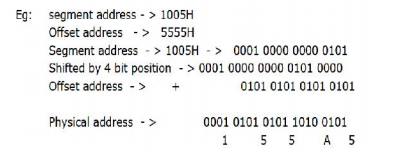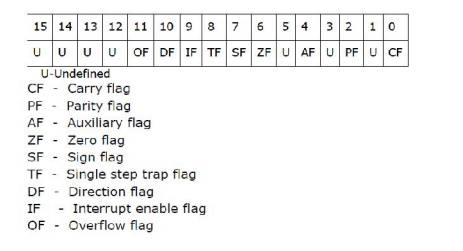Chapter: Microprocessor and Microcontroller : 8086 System Bus Structure
Important Short Questions and Answers: Microprocessor and Microcontroller - 8086 System Bus Structure
SYSTEM BUS STRUCTURE
1. Differentiate between minimum and maximum mode

2. Give any four pin definitions for the minimum
mode.

3. What are the pins that are used to indicate
the type of transfer in minimum mode?
The M/IO,
RD, WR lines specify the type of transfer. It is indicated in the following
table:

4. What
are the functional parts of 8086 CPU?
The two
independent functional parts of the 8086 CPU are: i. Bus Interface Unit (BIU):
BIU sends
out addresses, fetches instruction from memory, reads data from ports and
memory and writes data to ports and memory.
ii.
Execution Unit (EU):
EU tells
the BIU where to fetch instructions or data, decodes instructions and executes
instructions.
5. What
is the operation of S0, S1 and S2 pins in maximum mode?
S2, S1,
S0 indicates the type of transfer to take place during the current bus cycle.

6. Give
any four pin definitions for maximum mode.

7. Draw
the bus request and bus grant timings in minimum mode system.

8. What
is the purpose of a decoder in EU?
The
decoder in EU translates instructions fetched from memory into a series of
actions, which the EU carries out.
9. Give the
register classification of 8086. The 8086 contains:
i.
General purpose registers: They are used for holding data, variables and
intermediate results temporarily.
ii.
Special purpose registers: They are used as segment registers, pointers, index
register or as offset storage registers for particular addressing modes.
10.
What are general data registers?
The
registers AX,BX,CX and DX are the general data registers.

L and H
represents the lower and higher bytes of particular register. AX register is
used as 16-bit accumulator.
BX
register is used as offset storage for forming physical addresses in case of
certain addressing modes.
CX
register is used as a default counter in case of string and loop instructions.
DX
register is used as an implicit operand or destination in case of a few
instructions.
11.
Give the different segment registers. The four
segment registers are:
i. Code
segment register: It is used for addressing a memory location in the code
segment of the memory, where the executable program is stored.
ii. Data
segment register: It points to the data segment of the memory, where data is
resided. iii. Extra segment register: It also contains data.
iv. Stack
segment register: It is used for addressing stock segment of memory. It is used
to store stack data.
12.
What are pointers and index registers?
IP, BP and
SP are the pointers and contain offsets within the code, data and stack
segments respectively. SI and DI are the index registers, which are used as
general purpose registers
and also
for offset storage in case of indexed, based indexed and relative based indexed
addressing modes.
13.How is
the physical address calculated? Give an example.
The
physical address, which is 20-bits long is calculated using the segment and
offset registers, each 16-bits long. The segment address is shifted left
bit-wise four times and offset address is added to this to produce a 20 bit
physical address.

14. What
is meant by memory segmentation?
Memory
segmentation is the process of completely dividing the physically available
memory into a number of logical segments. Each segment is 64K byte in size and
is addressed by one of the segment register.
15. What
are the advantages of segmented memory? The advantages of segmented memory are:
i. Allows
the memory capacity to be 1Mbyte, although the actual addresses to be handled
are of 16-bit size.
ii. Allows
the placing of code, data and stack portions of the same program in different
parts of memory for data and code protection.
iii. Permits a
program and/or its data to be put into different areas of memory, each times
program is executed i.e., provision for relocation may be done.
16. What
is pipelining?
Fetching
the next instruction while the current instruction executes is called
pipelining
17. What
are the two parts of a flag register? The two parts of the 16 bit flag register
are: i. Condition code or status flag register:
It
consists of six flags to indicate some condition produced by an instruction.
ii. Machine control flag register:
It
consists of three flags and are used to control certain operations of the processor
18.Draw
the format of 8086 flag register. 8086 flag register:

19.
Explain the three machine control flags. i. Trap flag:
If this
flag is set, the processor enters the single step execution.
ii.
Interrupt flag: If this flag is set, the markable interrupts are recognized by
the CPU,
otherwise
they are ignored.
iii.
Direction flag: This is used by string manipulation instructions. If this flag
bit is „0‟,the string is processed from the lowest to the highest address i.e.,
auto incrementing mode. Otherwise, the string is processed from highest address
to lowest address, i.e., auto decrementing mode.
20. What
are the three groups of signals in 8086? The 8086 signals are categorized in
three groups. They are:
i. The
signals having common functions in minimum and maximum mode. ii. The signals
having special functions for minimum mode.
iii. The
signals having special functions for maximum mode.
21. What
are the uses of AD15 – AD0 lines?
AD15 –
AD0 are time multiplexed memory I/O address and data lines. Address remains on
the lines during T1 state, while data is available on data bus during T2, T3,
Tw and T4 states. These lines are active high and float to a tristate during
interrupt acknowledge and local bus hold acknowledge cycles.
22. What
is the operation of RD signal?
RD is an
active low signal. When it is low, it indicates the peripherals that the
processor is performing a memory or I/O read operation.
23.Give
the function of i. Ready and ii. INTR signal.
i. Ready
signal: It is an acknowledgement from slow devices of memory that they have
completed data transfer. The signal is synchronized by 8284 A clock generator
to give ready input to 8086. The signal is active high.
INTR
signal: It is a level triggered input. This is sampled during the last cycle of
each instruction to determine the availability of the request. If any interrupt
request is pending, the processor enters the interrupt acknowledge cycle. This
can be internally masked by resetting the interrupt enable flag. The signal is
active high and internally synchronized.
24. What
is the operation performed when TEST input is low?
When the
TEST input is low, execution will continue, else, the processor remains in an
idle state.
25. What
is NMI (Non-Maskable Interrupt)?
NMI is an
edge-triggered input, which causes a type 2 interrupt. It is not maskable internally
by software and transition from low to high initiate the interrupt response at
the end of the current instruction. This input is internally synchronized.
22. What
is the purpose of clock input?
The clock
input provides the basic timing for processor operation and bus control
activity. It is an asymmetric square wave with 33% duty cycle. The range of
frequency varies from 5MHz to 10MHz.
23. What
is the function of MN/MX pin?
The logic
level at MN/MX pin decides whether processor operates in minimum or maximum
mode.
24. What
happens when a high is applied to RESET pin?
When a
high is given to RESET pin, the processor terminates the current activity and
starts executing from FFFF0H. It must be active for at least four clock cycles.
It is internally synchronized.
25.
What will happen when a DMA request is made, while
the CPU is performing a memory or I/O cycles?
When a
DMA request is made, while the CPU is performing a memory or I/O cycles, it
will request the local bus during T4 provided:
i. The request
occurs on or before T2 state of the current cycle.
ii. The
current cycle is not operating over the lower byte of a word.
iii. The
current cycle is not the first acknowledge of an interrupt acknowledge
sequence. iv. A lock instruction is not being executed.
26.
What is multiprogramming?
If more
than one process is carried out at the same time, then it is know as
multiprogramming. Another definition is the interleaving of CPU and I/O
operations among several programs is called multiprogramming. To improve the
utilization of CPU and I/O devices, we are designing to process a set of
independent programs concurrently by a single CPU. This technique is known as
multiprogramming
27.
Write the advantages of loosely coupled system over
tightly coupled systems?
1. More number of CPUs can be added in a loosely coupled system to improve the system performance
2. The system structure is modular and hence easy to maintain and troubleshoot.
3. A fault
in a single module does not lead to a complete system breakdown.
28.
What is the different clock frequencies used in
80286?
Various
versions of 80286 are available that run on 12.5MHz, 10MHz and 8MHz clock
frequencies.
29.
Define swapping in?
The
portion of a program is required for execution by the CPU, it is fetched from
the secondary memory and placed in the physical memory. This is called
‘swapping in’ of the program.
30 What
are the different operating modes used in 80286? The 80286 works in two
operating modes
1. Real
addressing mode
2.
Protected virtual address mode.
31. What
are the CPU contents used in 80286?
The 80286
CPU contains almost the same set of registers, as in 8086
• Eight
16-bit general purpose register
• Four
16-bit segment registers
• Status
and control register
• Instruction pointer.
Related Topics